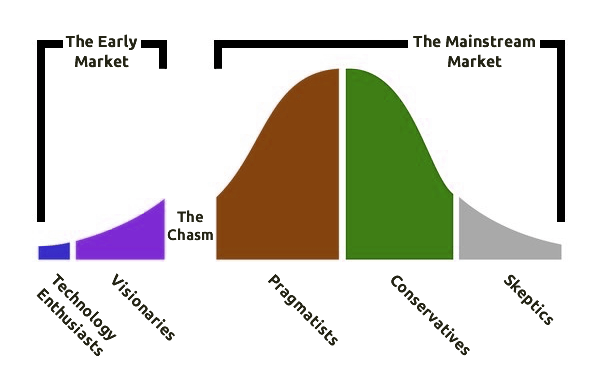When you run a business or are simply on the marketing team of a company, you’re always looking for ways to be more innovative and discover new opportunities. After reading Crossing the Chasm by Geoffrey A. Moore, you will gain new ideas for how to accomplish both of those tasks. It’s a great book filled with marketing lessons that can quickly be applied to just about any business.
The book is perhaps extra relevant to startups because it focuses on companies that have created new and highly disruptive products. Disruptive companies often have amazing products that need to find a way to be sold to the masses – they’re always thinking, “how do we get our product into the hands of as many customers as possible?”
In this post, we are going to examine startup lessons from Crossing the Chasm. There will be valuable lessons for every type of business scattered throughout our post.
Before we dig into Crossing the Chasm lessons, we should look at exactly what the user adoption curve is that the book talks about.
This is the user adoption curve:

Once you examine the general curve above, you need to break down the idea of the chasm into different segments.
These chasms are:
- Market requirements chasm.
- Product development chasm.
- Marketing and sales chasm.
- Customer support chasm.
Let’s dive deeper into each of these chasms:
1. Market requirements chasm
The market requirements chasm is the first chasm that you need to conquer. This is where you discover that your product truly satisfies a market need. While looking for your market fit, it’s important that you don’t pile on users. Stay focused on how to make your offering perfect for an identified opportunity.
2. Product development chasm
The product development chasm is another important one. It’s part of the never-ending product development cycle. As with the market requirements chasm, the focus is imperative here. Being focused means not adding tons of new features and making your core advantages as amazing as possible.
3. Marketing and sales chasm
When building a company, marketing and sales should often be a major expenditure. Focused is also important in marketing and sales because focus allows you to identify low-hanging fruit opportunities, outsmart the competition, and similar.
4. Customer support chasm
When a product is built with unfocused features, aimed at too wide of an audience, it becomes impossible for a company to support its customers. Customers will need a lot of help with installation or figuring out how to make a product work if it isn’t built in a focused way. This results in poor customer satisfaction and a high churn rate. You need to consider how each type of customer will be able to interact with your product if you want to be successful as a business.
Who are the types of people talking about in Crossing the Chasm?
In Crossing the Chasm, Moore highlights four types of buyers and users. These users are innovators, early adopters, early majority, late majority, and laggards.
Let’s dive into what each of these users means:
- Innovators: Innovators love new technology and expect problems with the products they’re using since they’re the first users.
- Early Adopters: Early adopters are customers who love to be part of a product early on, but they expect it to work.
- Early Majority: The early majority are the users who will only buy a product after they hear peer reviews. They want references to reassure them in their purchasing decisions.
- Late Majority: The late majority start using a product when it is no longer state-of-the-art. They use a product once most others have already adopted it.
- Laggards: Laggards are the very last people to purchase a product. This is because they tend to be skeptical and will only get a product once they’re effectively forced to get it.
The considerations about chasms and the different types of users that exist are great for a startup to consider. There are an insane amount of startup lessons scattered in the Crossing the Chasm book. The lessons are all rooted in the idea that if you know how different types of users will adopt your product, you will be able to better figure out how your business needs to evolve for each user type over time. Check our post on how can startups generate leads.
